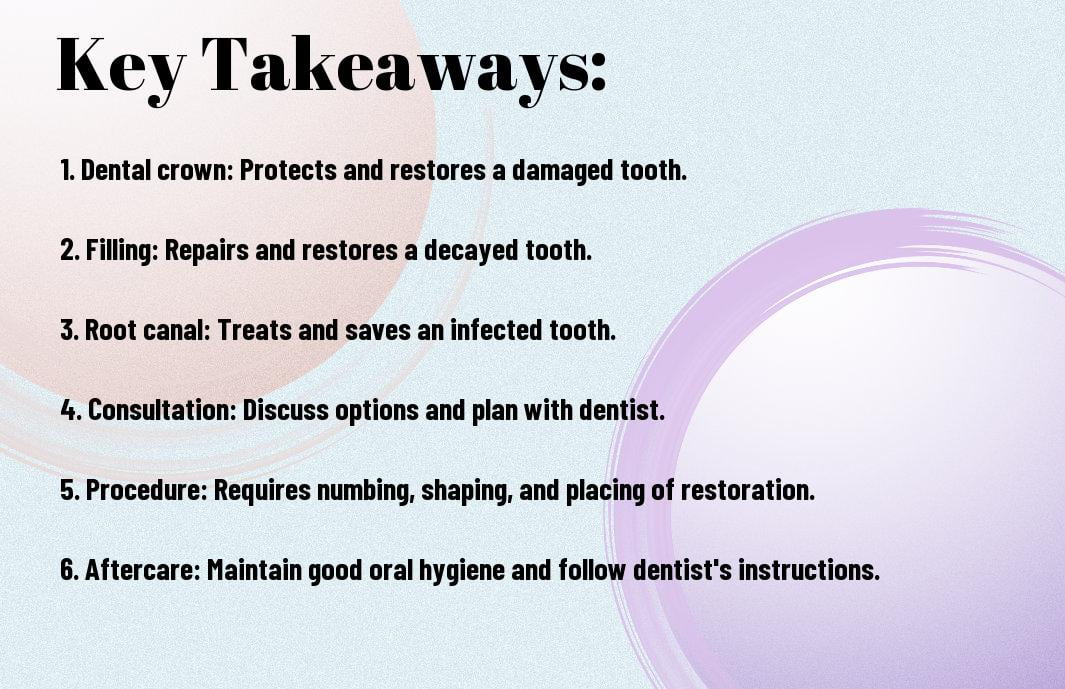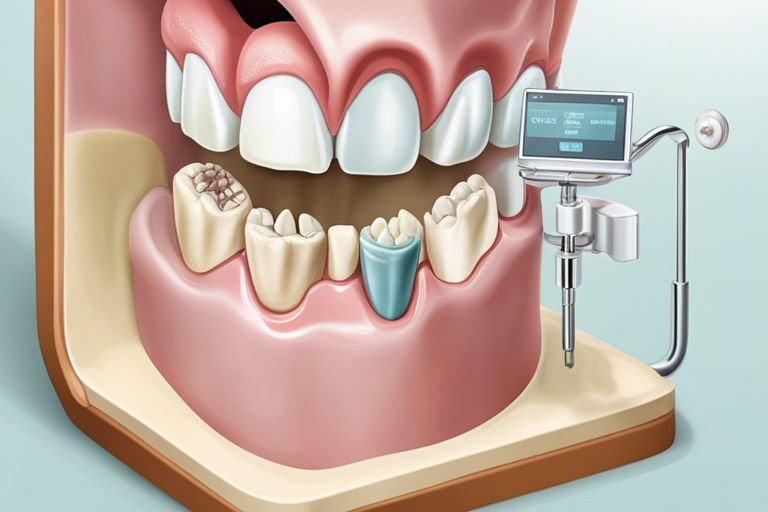Embarking on the journey to receive a dental crown, filling, or root canal can be a daunting prospect, but understanding the process can help alleviate any concerns. When you visit your dentist for a dental procedure, they will first assess the condition of your tooth and determine the best course of action to restore its health and function. In the case of a dental crown, your dentist will prepare the tooth by removing any decay or damage, and then take impressions to create a custom-fit crown that will be placed over the tooth. For a filling, the decayed portion of the tooth will be removed and filled with a material to restore its structure. And in the case of a root canal, the infected pulp inside the tooth will be removed, and the tooth will be sealed to prevent further infection. Throughout each procedure, your dentist will take measures to ensure your comfort and safety, and provide post-procedure instructions to promote healing and recovery.
Key Takeaways:
- The importance of early detection: It is crucial to address dental issues promptly to prevent further damage and the need for more invasive treatments.
- The different procedures: Understanding the process of getting a dental crown, filling, or root canal can help alleviate any anxiety or uncertainty about these common dental procedures.
- The importance of a skilled dentist: Finding a knowledgeable and experienced dentist is essential for ensuring the success and effectiveness of these treatments.
- Potential discomfort and recovery: Patients should be aware of the potential discomfort during and after the procedure, as well as the necessary aftercare to promote healing.
- The long-term benefits: Despite the initial discomfort, dental crowns, fillings, and root canals can restore function and appearance, ultimately improving overall dental health and wellbeing.
Dental Crowns
Obviously, a dental crown is a common dental procedure that many people undergo at some point in their lives. If you have recently had a root canal, you may be wondering if you always need a crown afterward. To learn more about this topic, you can read Do You Always Need a Crown after a Root Canal?
When is a Dental Crown Needed?
A dental crown is typically recommended in a few situations. If you have a tooth that is severely damaged or weakened, a crown can provide protection and support. Crowns are also used to cover and protect a tooth after a root canal treatment. Your dentist will evaluate your specific situation to determine if a dental crown is necessary.
Types of Dental Crowns
When it comes to dental crowns, there are several types to choose from including porcelain, ceramic, metal, and porcelain-fused-to-metal. Your dentist will help you decide which type is best for you based on the location of the tooth, your budget, and your personal preferences. After an in-depth discussion, you and your dentist can decide on the best option for your needs.
| Type of Dental Crown | Characteristics |
| Porcelain | Natural appearance, best for front teeth |
| Ceramic | Metal-free, natural-looking |
| Metal | Durable, best for back teeth |
| Porcelain-fused-to-metal | Natural appearance with added strength |
| Zirconia | Exceptionally durable and natural-looking |
The Step-by-Step Crown Procedure
The process of getting a dental crown involves several steps. First, your dentist will prepare the tooth by removing any decay and shaping it to accommodate the crown. Then, impressions of your tooth will be taken to create a custom-fitted crown. Your dentist will place a temporary crown while the permanent one is being made. Once ready, the permanent crown is cemented into place.
| Step | Description |
| Tooth Preparation | Decay removal and shaping of the tooth |
| Impression Taking | Creation of a custom-fitted crown |
| Temporary Crown Placement | Protection of the prepared tooth |
| Permanent Crown Placement | Cementing of the final crown |
Aftercare and Maintenance of Dental Crowns
After getting a dental crown, it is essential to take care of it to ensure its longevity. You should maintain good oral hygiene by brushing and flossing regularly and attending regular dental check-ups. Avoid chewing hard foods or using your teeth to open packages to prevent damage to the crown. If you notice any discomfort or issues with your crown, contact your dentist for an evaluation.
Dental Fillings
Unlike dental crowns or root canals, dental fillings are typically used to treat smaller areas of decay on a tooth. Fillings are a common procedure and can help restore your tooth’s function and appearance.
Identifying Cavities for Fillings
When you visit your dentist for a check-up, they will thoroughly examine your teeth to identify any cavities that may require fillings. X-rays may be taken to identify hidden areas of decay. If a cavity is detected, your dentist will recommend a filling to prevent further damage to the tooth.
Material Options for Dental Fillings
There are several materials used for dental fillings, including amalgam, composite resin, ceramic, and glass ionomer. The best option for you will depend on the location and size of the cavity, as well as your budget and personal preferences. Your dentist will discuss the options with you and help you make the best choice for your specific needs.
The Filling Process Explained
During the filling process, the decayed portion of the tooth is removed and the area is thoroughly cleaned. The chosen filling material is then placed into the cavity and shaped to match the natural contours of the tooth. The filling is hardened using a special light or chemical process. Your dentist will ensure the filling fits properly and doesn’t interfere with your bite.
Tips for Longevity of Dental Fillings
Proper oral hygiene is crucial for the longevity of your fillings. You should brush your teeth at least twice a day, floss regularly, and visit your dentist for routine check-ups. Avoid biting down on hard objects and be mindful of foods that could potentially stick to or damage your fillings. Knowing how to care for your fillings can help them last for years to come.
- Brush your teeth at least twice a day with fluoride toothpaste.
- Floss between your teeth daily to remove plaque and food particles.
- Visit your dentist for regular cleanings and check-ups every six months.
- Avoid chewing on hard objects such as ice or pens to prevent damage to your fillings.
Root Canal Treatment
Now, let’s dive into the process of a root canal treatment, a dental procedure designed to save a tooth that is infected or damaged.
Understanding the Need for a Root Canal
If you are experiencing severe tooth pain, prolonged sensitivity to hot or cold, or discoloration of the tooth, you may need a root canal. These symptoms can indicate an infection or damage to the innermost layer of your tooth, the dental pulp. A root canal is necessary when the pulp becomes inflamed or infected, putting you at risk of losing the tooth if left untreated.
Root Canal Procedure: A Detailed Walkthrough
The root canal procedure involves removing the infected or damaged pulp from the tooth, cleaning and disinfecting the inside of the tooth, and then sealing it to prevent further infection. During the procedure, your dentist will numb the area around the tooth to ensure you are comfortable throughout. Using specialized tools, they will access the inner chamber of the tooth, remove the infected tissue, and carefully clean and shape the root canal before filling and sealing it with a rubber-like material.
Post-Root Canal Care and Recovery
After your root canal treatment, you may experience some discomfort or mild pain as the anesthesia wears off. You can manage any discomfort with over-the-counter pain relievers. It is important to follow your dentist’s aftercare instructions, which may include avoiding chewing on the treated tooth until a permanent restoration, such as a crown, is placed. It is essential to attend any follow-up appointments to ensure proper healing and to complete the restoration of the tooth.
Misconceptions about Root Canal Treatment
There are common misconceptions about root canal treatment, including the belief that it is a painful procedure. In reality, modern techniques and anesthesia make root canals relatively comfortable. Additionally, some people believe that a tooth extraction is a better alternative to a root canal. However, saving your natural tooth with a root canal is the best option for maintaining a healthy smile and avoiding the long-term consequences of tooth loss.
By understanding the process and importance of a root canal treatment, you can make informed decisions about your dental health.Remember, addressing dental issues promptly can prevent further complications and preserve your natural smile for years to come. If you are experiencing symptoms of a potential root canal, it is crucial to seek professional dental care as soon as possible to avoid further damage to your tooth.
Conclusion: The Process Of Getting A Dental Crown, Filling, Or Root Canal
With this in mind, it is important to understand the process of getting a dental crown, filling, or root canal. These treatments are essential for restoring the health and function of your teeth, and they are often necessary to prevent further damage and discomfort. By working closely with your dentist, you can ensure that the procedure is customized to your specific needs and that you are well-informed about the steps involved. Remember to follow any post-procedure care instructions provided by your dentist to ensure the best outcome for your dental treatment. With proper care and maintenance, your dental crown, filling, or root canal can last for many years, keeping your smile healthy and beautiful.
FAQ
Q: What is the process of getting a dental crown?
A: The process of getting a dental crown involves several steps. First, the dentist will prepare the tooth by shaping it to fit the crown. Then, an impression of the tooth will be taken and sent to a dental lab where the crown will be custom-made. In the meantime, a temporary crown may be placed on the tooth. Once the permanent crown is ready, it will be fitted and cemented into place.
Q: What is the process of getting a dental filling?
A: The process of getting a dental filling begins with the dentist numbing the area around the tooth to be filled. The decayed or damaged portion of the tooth is then removed, and the remaining space is filled with a material such as amalgam, composite resin, or porcelain. The filling is shaped and polished to restore the tooth’s shape, function, and appearance.
Q: What is the process of getting a root canal?
A: The process of getting a root canal starts with the dentist numbing the area around the affected tooth. Then, a small opening is made in the top of the tooth to access the infected or inflamed pulp. The pulp is removed, and the inside of the tooth is cleaned and disinfected. Finally, the tooth is filled and sealed with a rubber-like material, and a crown is often placed on top to protect and restore the tooth’s function.







